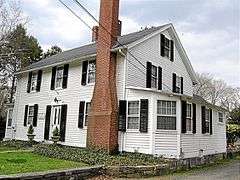Middle Haddam Historic District
|
Middle Haddam Historic District | |
|
The Ralph Smith House | |
  | |
| Location | Moodus and Long Hill Rds., East Hampton, Connecticut |
|---|---|
| Coordinates | 41°33′11″N 72°33′6″W / 41.55306°N 72.55167°WCoordinates: 41°33′11″N 72°33′6″W / 41.55306°N 72.55167°W |
| Area | 110 acres (45 ha) |
| Built | 1730 |
| Architectural style | Mid 19th Century Revival, Federal, Colonial |
| NRHP Reference # | [1] |
| Added to NRHP | February 3, 1984 |
The Middle Haddam Historic District is a historic district in the town of East Hampton, Connecticut. It encompasses a small residential area, in which most of the housing stock was built between 1750 and the mid-19th century. Middle Haddam was an important port on the Connecticut River between about 1730 and 1880, acting as a shipment point for trade with the West Indies and the North American coast, and as the site of shipyards building ocean-going vessels. The most prominent building in the village is the Second Congregational Church, built in 1855 and given High Victorian styling in the 1870s.[2]
Among others, the Princeton University and Yale Divinity School-educated Second Great Awakening evangelist James Brainerd Taylor (1801–1829) was born in Middle Haddam's historic district. As a boy, Taylor attended the town's still-standing Christ Episcopal Church (est. 1786).
The district was listed on the National Register of Historic Places in 1984.[1]
See also
References
- 1 2 National Park Service (2009-03-13). "National Register Information System". National Register of Historic Places. National Park Service.
- ↑ "NRHP nomination for Middle Haddam Historic District" (PDF). National Park Service. Retrieved 2014-11-26.
